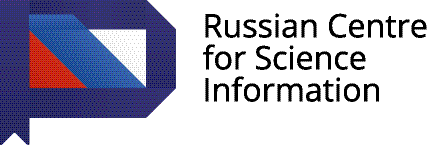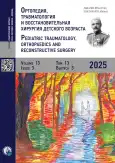Conradi–Hünermann综合征患儿脊柱后凸侧弯畸形的外科矫正(病例报告与文献综述)
- 作者: Asadulaev M.S.1, Vissarionov S.V.1, Pershina P.A.1, Malamashin D.B.1, Toria V.G.1, Kokushin D.N.1, Rybinskikh T.S.1, Belyanchikov S.M.1, Murashko T.V.1
-
隶属关系:
- H. Turner National Medical Research Center for Сhildren’s Orthopedics and Trauma Surgery
- 期: 卷 13, 编号 3 (2025)
- 页面: 307-318
- 栏目: Clinical cases
- URL: https://bakhtiniada.ru/turner/article/view/349953
- DOI: https://doi.org/10.17816/PTORS689632
- EDN: https://elibrary.ru/DCHNKI
- ID: 349953
如何引用文章
详细
论证。Conradi–Hünermann综合征,又称X连锁显性点状软骨发育不良2型(CDPX2),是一种罕见的遗传性疾病。其患病率为每100,000–400,000名新生儿1例,女性患者占比超过95%。在儿童脊柱外科中,后凸和后凸侧弯畸形因进展迅速并导致严重畸形而具有重要临床意义。然而,在俄罗斯国内文献中,有关该综合征诊断和治疗的研究报道仍极为有限。
临床观察。本文报道了一名3岁3个月Conradi–Hünermann综合征患儿的病史、遗传学检查及临床–影像学检查资料。展示了外科治疗结果,并讨论了手术策略选择的可能途径。
讨论。在低龄患儿(2–5 岁)中,脊柱在冠状面和矢状面形成严重畸形(超过50°Cobb角),是明确的不良预后因素。对于此类患者,在幼年期及时进行脊柱畸形的外科矫正,并通过多支撑金属内固定稳定矫正结果,是必要的措施,其目的在于防止神经功能缺损的发生以及在儿童后续生长过程中畸形的迅速进展。
结论。对疑似Conradi–Hünermann综合征的儿童应尽早进行临床和遗传学诊断。应监测其骨科状态,以便及时转诊至脊柱外科专家。进展性后凸侧弯畸形的治疗应包括早期外科干预。其可行方案可以是在不进行早期脊柱融合的情况下,通过多支撑金属内固定进行畸形矫正和稳定,并在必要时于随后的生长阶段实施分期矫正。
作者简介
Marat S. Asadulaev
H. Turner National Medical Research Center for Сhildren’s Orthopedics and Trauma Surgery
编辑信件的主要联系方式.
Email: marat.asadulaev@yandex.ru
ORCID iD: 0000-0002-1768-2402
SPIN 代码: 3336-8996
MD, Cand. Sci. (Medicine)
俄罗斯联邦, Saint PetersburgSergei V. Vissarionov
H. Turner National Medical Research Center for Сhildren’s Orthopedics and Trauma Surgery
Email: vissarionovs@gmail.com
ORCID iD: 0000-0003-4235-5048
SPIN 代码: 7125-4930
MD, Dr. Sci. (Medicine), Professor, Corresponding Member of RAS
俄罗斯联邦, Saint PetersburgPolina A. Pershina
H. Turner National Medical Research Center for Сhildren’s Orthopedics and Trauma Surgery
Email: polinaiva2772@gmail.com
ORCID iD: 0000-0001-5665-3009
SPIN 代码: 2484-9463
MD
俄罗斯联邦, Saint PetersburgDenis B. Malamashin
H. Turner National Medical Research Center for Сhildren’s Orthopedics and Trauma Surgery
Email: malamashin@mail.ru
ORCID iD: 0000-0002-7356-6860
SPIN 代码: 9650-6020
MD, Cand. Sci. (Medicine)
俄罗斯联邦, Saint PetersburgVakhtang G. Toria
H. Turner National Medical Research Center for Сhildren’s Orthopedics and Trauma Surgery
Email: vakdiss@yandex.ru
ORCID iD: 0000-0002-2056-9726
SPIN 代码: 1797-5031
MD
俄罗斯联邦, Saint PetersburgDmitriy N. Kokushin
H. Turner National Medical Research Center for Сhildren’s Orthopedics and Trauma Surgery
Email: partgerm@yandex.ru
ORCID iD: 0000-0002-2510-7213
SPIN 代码: 9071-4853
MD, Dr. Sci. (Medicine)
俄罗斯联邦, Saint PetersburgTimofey S. Rybinskikh
H. Turner National Medical Research Center for Сhildren’s Orthopedics and Trauma Surgery
Email: timofey1999r@gmail.com
ORCID iD: 0000-0002-4180-5353
SPIN 代码: 7739-4321
MD
俄罗斯联邦, Saint PetersburgSergei M. Belyanchikov
H. Turner National Medical Research Center for Сhildren’s Orthopedics and Trauma Surgery
Email: beljanchikov@list.ru
ORCID iD: 0000-0002-7464-1244
SPIN 代码: 9953-5500
MD, Cand. Sci. (Medicine)
俄罗斯联邦, Saint PetersburgTatiana V. Murashko
H. Turner National Medical Research Center for Сhildren’s Orthopedics and Trauma Surgery
Email: popova332@mail.ru
ORCID iD: 0000-0002-0596-3741
SPIN 代码: 9295-6453
MD
俄罗斯联邦, Saint Petersburg参考
- rarediseases.org [Internet]. Conradi Hünermann Syndrome. National Organization for Rare Disorders (NORD). Danbury (CT): NORD; 2021. [cited 2025 Aug 10] Available from: https://rarediseases.org/rare-diseases/conradi-hunermann-syndrome
- Mason DE, Sanders JO, MacKenzie WG, et al. Spinal deformity in chondrodysplasia punctata. Spine (Phila Pa 1976). 2002;27(18):1995–2002. doi: 10.1097/00007632-200209150-00007
- Lykissas MG, Sturm PF, McClung A, et al. Challenges of spine surgery in patients with chondrodysplasia punctata. J Pediatr Orthop. 2013;33(7):685–693. doi: 10.1097/BPO.0b013e31829e86a9
- Kabirian N, Hunt LA, Ganjavian MS, et al. Progressive early-onset scoliosis in Conradi disease: a 34-year follow-up of surgical management. J Pediatr Orthop. 2013;33(2):e4–e9. doi: 10.1097/BPO.0b013e31827364a5
- Kelley RI, Wilcox WG, Smith M, et al. Abnormal sterol metabolism in patients with Conradi-Hunermann-Happle syndrome and sporadic lethal chondrodysplasia punctata. Am J Med Genet. 1999;83(3):213–219. doi: 10.1002/(sici)1096-8628(19990319)83:3<213::aid-ajmg15>3.0.co;2-c
- Derry JM, Gormally E, Means GD, et al. Mutations in a Δ8-Δ7 sterol isomerase in the tattered mouse and X-linked dominant chondrodysplasia punctata. Nat Genet. 1999;22(3):286–290. doi: 10.1038/10350
- Braverman N, Lin P, Moebius FF, et al. Mutations in the gene encoding 3β-hydroxysteroid-Δ8, Δ7-isomerase cause X-linked dominant Conradi-Hunermann syndrome. Nat Genet. 1999;22(3):291–294. doi: 10.1038/10357
- Herman GE, Walton SJ. Close linkage of the murine locus bare patches to the X-linked visual pigment gene: implications for mapping human X-linked dominant chondrodysplasia punctata. Genomics. 1990;7(3):307–312. doi: 10.1016/0888-7543(90)90162-n
- Herman GE, Kelley RI, Pureza V, et al. Characterization of mutations in 22 females with X-linked dominant chondrodysplasia punctata (Happle syndrome). Genet Med. 2002;4(6):434–438. doi: 10.1097/00125817-200211000-00006
- Bukkems SF, Ijspeert WJ, Vreenurg M, et al. Conradi-Hünermann-Happle syndrome. Ned Tijdschr Geneeskd. 2012;156(10):A4105. (In Dutch).
- Braverman N, Steel G, Obie C, et al. Human PEX7 encodes the peroxisomal PTS2 receptor and is responsible for rhizomelic chondrodysplasia punctata. Nat Genet. 1997;15(4):369–376. doi: 10.1038/ng0497-369
- Has C, Seedorf U, Kannenberg F, et al. Gas chromatography-mass spectrometry and molecular genetic studies in families with the Conradi-Hünermann-Happle syndrome. J Invest Dermatol. 2002;118(5):851–858. doi: 10.1046/j.1523-1747.2002.01761.x EDN: BANFKP
- Cardoso ML, Barbosa M, Serra D, et al. Living with inborn errors of cholesterol biosynthesis: lessons from adult patients. Clin Genet. 2014;85(2):184–188. doi: 10.1111/cge.12139
- Corbí MR, Conejo-Mir JS, Linares M, et al. Conradi-Hünermann syndrome with unilateral distribution. Pediatr Dermatol. 1998;15(4):299–303. doi: 10.1046/j.1525-1470.1998.1998015299.x
- Aughton DJ, Kelley RI, Metzenberg A, et al. X-linked dominant chondrodysplasia punctata (CDPX2) caused by single gene mosaicism in a male. Am J Med Genet A. 2003;116A(3):255–260. doi: 10.1002/ajmg.a.10852
- Kumble S, Savarirayan R. Chondrodysplasia punctata 2, X-linked. In: Adam MP, Feldman J, Mirzaa GM, et al., editors. GeneReviews®. Seattle (WA): University of Washington: Seattle; 2011.
- Ryabykh SO, Ulrich EV, Mushkin AYu, et al. Treatment of congenital spinal deformities in children: yesterday, today, tomorrow. Spine Surgery. 2020;17(1):15–24. doi: 10.14531/ss2020.1.15-24 EDN: EMPNLO
- Kuleshov AA, Vetrile MS, Lisyansky IN, et al. Surgical treatment of a patient with congenital deformity of the spine, the thoracic and lumbar pedicle aplasia, and spinal compression syndrome. Spine Surgery. 2016;13(3):41–48. doi: 10.14531/ss2016.3.41-48 EDN: WKYPBR
- Vissarionov SV, Murashko VV, Murashko TV, et al. Surgical treatment of patients with congenital deformities in multilevel bilateral thoracic and lumbar pedicle aplasia. Spine Surgery. 2015;12(3):19–27. doi: 10.14531/ss2015.3.19-27 EDN: UMGWNL
- Sutphen R, Amar MJ, Kousseff BG, et al. XXY male with X-linked dominant chondrodysplasia punctata (Happle syndrome). Am J Med Genet. 1995;57(3):489–492. doi: 10.1002/ajmg.1320570326
- Hatia M, Roxo D, Pires MS, et al. Chondrodysplasia punctata: early diagnosis and multidisciplinary management of Conradi-Hünermann-Happle syndrome (CDPX2). Cureus. 2024;16(12):e75605. doi: 10.7759/cureus.75605
- De Jesus S, Costa ALR, Almeida M, et al. Conradi-Hünerman-Happle syndrome and obsessive-compulsive disorder: a clinical case report. BMC Psychiatry. 2023;23(1):87. doi: 10.1186/s12888-023-04579-1 EDN: HZCXZF
- Happle R. X-linked dominant chondrodysplasia punctata/ichthyosis/cataract syndrome in males. Am J Med Genet. 1995;57(3):493. doi: 10.1002/ajmg.1320570327
- Capelozza Filho L, de Almeida Cardoso M, Caldeira EJ, et al. Ortho-surgical management of a Conradi-Hünermann syndrome patient: rare case report. Clin Case Rep. 2015;3(8):694–701. doi: 10.1002/ccr3.307
- Happle R. X-linked dominant chondrodysplasia punctata: review of literature and report of a case. Hum Genet. 1979;53(1):65–73. doi: 10.1007/BF00278240 EDN: KBXMMA
- Vissarionov SV. Surgical treatment of segmental instability of the thoracic and lumbar spine in children [dissertation abstract]. Novosibirsk: Novosibirsk Research Institute of Traumatology and Orthopedics; 2008. 165 p. EDN: NQLDFL (In Russ.)
- Vissarionov SV, Khusainov NO, Kokushin DN. Analysis of results of treatment without-of-spine-based implants in patients with multiple congenital anomalies of the spine and thorax. Pediatric Traumatology, Orthopaedics and Reconstructive Surgery. 2017;5(2):5–12. doi: 10.17816/PTORS525-12 EDN: WGMTGO
- Mikhaylovskiy MV, Ulrich EV, Suzdalov VA, et al. VEPTR instrumentation in the surgery for infantile and juvenile scoliosis: first experience in Russia. Spine Surgery. 2010;(3):31–41. doi: 10.14531/ss2010.3.31-41 EDN: MUPPIJ
- Murphy RF, Moisan A, Kelly DM, et al. Use of vertical expandable prosthetic titanium rib (VEPTR) in the treatment of congenital scoliosis without fused ribs. J Pediatr Orthop. 2016;36(4):329–335. doi: 10.1097/BPO.0000000000000460
- Tsirikos AI, Roberts SB. Magnetic controlled growth rods in the treatment of scoliosis: safety, efficacy and patient selection. Med Devices (Auckl). 2020;13:75–85. doi: 10.2147/MDER.S198176
补充文件

















